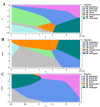The role of plants in the formation of species-specific features in grass flies (Diptera, Chloropidae, Meromyza)
- PMID: 35002370
- PMCID: PMC8732877
- DOI: 10.3897/BDJ.9.e78017
The role of plants in the formation of species-specific features in grass flies (Diptera, Chloropidae, Meromyza)
Abstract
In the current manuscript, we present the results of comparative analysis of seven species of Meromyza flies in the "variegata" cluster and of the evolutionary close species M.inornata, based the following criteria: 1) 14 external key features; 2) shape and area of the anterior processes of postgonites; 3) mtDNA CO1 region and 4) host plant diversity data. We could demonstrate the primary role of host plants in species formation inside genus Meromyza and calculated the timing of the divergence of M.inornata and the species of "variegata" cluster. Based on our estimates of evolution rate for mtDNA CO1 gene, we could conclude that that divergence of herbs happened before the speciation of grass flies Meromyza. Meromyza species, close to the ancestral species of the cluster, are adapted to the wide range of host plants. We revealed the most informative variables h1, S and Plant analysing data with the following statistical methods: linear discriminant analysis - LDA, regularised discriminant analysis - RDA, flexible discriminant analysis - FDA and probabilistic neural network - PNN. The highest classification accuracy was achieved using PNN (99%) and the lowest when using LDA (95.8%). When the Plant trait was excluded, the classification accuracy decreased by 14%. We revealed the significant trends in size change of the anterior process of the postgonite amongst studies species. This morphological structure is an element of male reproductive apparatus critical for the restriction of interspecies mating. We determined three branches of speciation in the "variegata" cluster and five trends in the evolution of this cluster, based on the external morphological features. We showed that M.variegata and especially M.mosquensis, the species closest to the ancestral haplotype, have the largest number of features typical of those of M.inornata. Based on the external features and the area of the anterior process of the postgonite, we reconstructed the phylogenetic position of M.elbergi in the cluster. In accordance with the obtained outcomes, we could conclude that the distribution, species diversity and the adaptation of the grass flies to narrow oligophagy were directly connected to host plant diversity. The adaptation to different host plants could be the main factor in divergence of grass flies and their evolution started later than the diversification in the Pooideae subfamily of grasses.
Keywords: Poaceae; co-evolution insect-plant; morphometric; mtDNA CO1; postgonites.
Tatiana A. Triseleva, Varos G. Petrosyan, Aleksandra A. Yatsuk, Andrey F. Safonkin.
Figures







Similar articles
-
Variability of the key features and revision of a group of closely related species of grassflies (Diptera, Chloropidae, Meromyza).Zookeys. 2020 Jun 18;942:65-75. doi: 10.3897/zookeys.942.49644. eCollection 2020. Zookeys. 2020. PMID: 32612442 Free PMC article.
-
[Distribution of fruit flies (Chloropidae: Meromyza Mg.) in Vologda oblast and east Poland].Izv Akad Nauk Ser Biol. 2013 Sep-Oct;(5):614-23. Izv Akad Nauk Ser Biol. 2013. PMID: 25510115 Russian.
-
[Phylogenetic relations between frit fly groups from the genus Meromyza based on genetic and morphological analysis].Izv Akad Nauk Ser Biol. 2014 May-Jun;(3):213-8. Izv Akad Nauk Ser Biol. 2014. PMID: 25731030 Russian.
-
[Factors Affecting the Dynamics of Circadian Activity of Frit Flies Meromyza saltatrix (L) (Diptera: Chloropidae)].Izv Akad Nauk Ser Biol. 2015 Nov-Dec;(6):661-7. Izv Akad Nauk Ser Biol. 2015. PMID: 26852486 Russian.
-
Polyploidy and interspecific hybridization: partners for adaptation, speciation and evolution in plants.Ann Bot. 2017 Aug 1;120(2):183-194. doi: 10.1093/aob/mcx079. Ann Bot. 2017. PMID: 28854567 Free PMC article. Review.
References
-
- Becker Th. Chloropidae. Eine monographische studie. 1. Tiel. Paläarctische region. Archivum Zoologicum. 1910;1(10):44.
-
- Chesson P. Mechanisms of maintenance of species diversity. Annual Review of Ecology and Systematics. 2000;31:343–366. doi: 10.1146/annurev.ecolsys.31.1.343. - DOI
-
- Fedoseeva LI. The species of the genus Meromyza Meig. (Diptera, Chloropidae) in the environs of Moscow. Entomologicheskoe Obozrenie. 1960;89(2):450–461. Russian.
LinkOut - more resources
Full Text Sources
